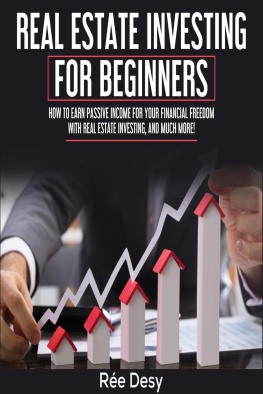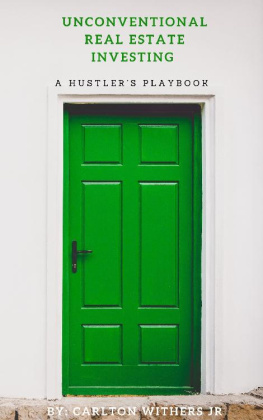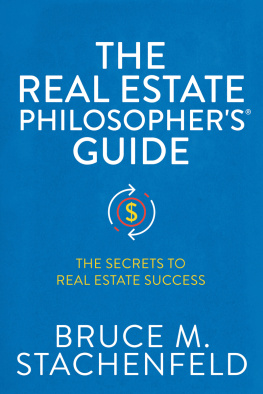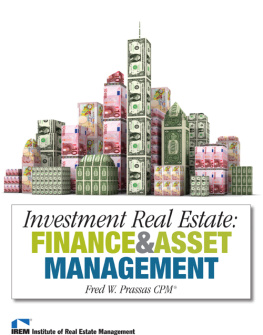Willam Bragg Ewald - Trammell Crow: A Legacy in Real Estate Innovation
Here you can read online Willam Bragg Ewald - Trammell Crow: A Legacy in Real Estate Innovation full text of the book (entire story) in english for free. Download pdf and epub, get meaning, cover and reviews about this ebook. year: 2012, publisher: Urban Land Institute, genre: Detective and thriller. Description of the work, (preface) as well as reviews are available. Best literature library LitArk.com created for fans of good reading and offers a wide selection of genres:
Romance novel
Science fiction
Adventure
Detective
Science
History
Home and family
Prose
Art
Politics
Computer
Non-fiction
Religion
Business
Children
Humor
Choose a favorite category and find really read worthwhile books. Enjoy immersion in the world of imagination, feel the emotions of the characters or learn something new for yourself, make an fascinating discovery.
- Book:Trammell Crow: A Legacy in Real Estate Innovation
- Author:
- Publisher:Urban Land Institute
- Genre:
- Year:2012
- Rating:5 / 5
- Favourites:Add to favourites
- Your mark:
- 100
- 1
- 2
- 3
- 4
- 5
Trammell Crow: A Legacy in Real Estate Innovation: summary, description and annotation
We offer to read an annotation, description, summary or preface (depends on what the author of the book "Trammell Crow: A Legacy in Real Estate Innovation" wrote himself). If you haven't found the necessary information about the book — write in the comments, we will try to find it.
Based on interviews with colleagues, friends, and enemies, this biography tells the story of how a man without money, experience, or connections became a real estate legend. A visionary and risk taker, Trammell Crow is presented in the book as the pioneer of speculative real estate development, noted for spawning a generation of industry leaders.
Trammell Crow: A Legacy in Real Estate Innovation — read online for free the complete book (whole text) full work
Below is the text of the book, divided by pages. System saving the place of the last page read, allows you to conveniently read the book "Trammell Crow: A Legacy in Real Estate Innovation" online for free, without having to search again every time where you left off. Put a bookmark, and you can go to the page where you finished reading at any time.
Font size:
Interval:
Bookmark:

2005 by ULI-the Urban Land Institute
All rights reserved. No part of this book may be reproduced in any form or by any means, electronic or mechanical, including photocopying and recording, or by any information storage and retrieval system, without written permission of the publisher.
ULI-the Urban Land Institute
1025 Thomas Jefferson Street, N.W.
Suite 500 West
Washington, D.C. 20007-5201
Ewald, William Bragg, Jr.
Trammell Crow: A Legacy of Real Estate Business Innovation.
Washington, D.C.: ULI-the Urban Land Institute, 2005.
ISBN: 0-87420-935-8
Library of Congress Control Number: 2005922783
Printed in the United States of America.
10 9 8 7 6 5 4 3 2 1
For Margaret Crow
T his is a story of a man of business, a man many people have never heard of
Trammell Crow of Dallas.
Why write about him?
Because as a one-of-a-kind individualin his character, personality, surprises, speed of mind, convictions, compulsive optimism, shortcomings, energy, and, above all, his singular ethicshe far out-fascinates most billionaires, most CEOs, indeed most people.
Because he rose farther in his businessreal estate developmentthan anyone else ever has, and because he therefore had farther to fall.
Because his features as an individual mesh inexorably with the driving buoyancy and the treacherous economic follies of our time.
This is therefore a story of dramatic tensions: between the forces within a man and his country that powered an egregious business ascent and the undertow forces within a man and his country that propelled him earthward. It is a morality play about transcendenceabout what remains when both a business and a society founder. This is a story that recounts how a man, though the heavens may seem to fall, can sometimes still come through triumphant.
When Trammell asked me to write this book, I said that, to me, business histories usually fall into two types: sanitized, self-serving documents blue-penciled by the company, and documents in which the author, unfettered, calls the facts as he sees them.
What kind do you want?
The second.
And he has remained true to his word, opening doors to sources, insisting that I speak to his enemies as well as his friends, and disclaiming any right whatsoever to modify anything in the book.
Accordingly, in the intervening years, I have interviewed these close-in witnesses inside and outside the Crow company, their names listed as they appear in the text: Tom Bailey, Willard Baker, Pete Baldwin, Claude Ballard, Lloyd Bentsen, Randy Best, Jim Biddle, Lucy Crow Billingsley, Mike Birnbaum, Don Bowles, Cloyce Box, Henri Bromberg, Bart Brown, Steve Brown, William Brueggeman, L. Travis Brannon, Cary Brazeman, Bill Campbell, Jim Carreker, Frank Carter, Don Childress, David Clossey, Barbara Collins, Charles Colson, Bill Cooper, Davis Crow, Harlan Crow, Howard Crow, Margaret Crow, Michael Crow, Stuart Crow, Trammell Crow, Trammell S. Crow, Tom Daniel, Lillian Davey, Kim Dawson, Bill Dillard, Gus Dubinsky, Hayden Eaves, Sue Edwards, Joel Ehrenkranz, Gerald Ford, Darrell Francis, Joel Garreau, Vince George, Bob Glaze, Terence Golden, Sandy Gottesman, Ron Green, A.C. Greene, John Grieco, Sue Groenteman, Allan Hamilton, Hope Hamilton, Jess Hay, Jim Hendricks, Barry Henry, Ben Holloway, Robin Hood, Carl Huebner, Jake Jacobson, George Jenkins, Grady Jordan, Glen Justice, Peter Justiniano, Louise Kahn, Alex Kerr, David Kiger, Bob Kresko, Tom Landry, A.J. Land, Bill Leahy, Ken Leventhal, Bill Maddux, Stanley Marcus, Alan Maxwell, Buzz McCoy, Dick Michaux, Elsa Miller, Henry Miller, Elise Mobley, Marc Myers, Mike Novelli, Jean ONeal, Joel Peterson, Mack Pogue, John Portman, David Rockefeller, Harvey Rosenblum, Don Russell, Gary Shafer, George Shafer, Overton Shelmire, David Shulman, Tom Shutt, Tom Simmons, Kathleen Smalley, Ned Spieker, John Stemmons, Charles Storey, Roger Sullivan, Don Taylor, Ron Terwilliger, King Upton, Wolf Vedder, Denny Wallace, Bob Whitman, Don Williams, Bill Winsor, and Bob Wright.
In addition, I have supplemented these face-to-face questionings with a number of transcripts of earlier interviews conducted by others and handed over to me by Trammell Crow.
Roy Rowan, a gifted author and valued friend, launched this entire project by asking me, years ago, whether I had ever heard of Trammell Crow.
My late wife, Mary, joined in many of the exploratory interviews behind the book. Our three sons provided good encouragement all along the way. And one of them, Charles, brought to his intensive reading of the final manuscript a particularly close familiarity with the factual framework of the story.
In the process of publication, I owe large debts to Jacques de Spoelberch, an agent of great civility and insightful understanding; to Susan Scharmett, a skilled and meticulous producer of beautifully typed pages; and to Micaela Porta, a keen-eyed and spirited professional editor for the Urban Land Institute. To all these, and to many more friends along the way, my warmest thanks.
And above all, my thanks to Trammell Crow himself, and to his son Harlan, and his incomparable wife Margaret, to whom the book is dedicated.
William Bragg Ewald, Jr.

G EORGE PATTON WAS a man for World War II, an astute real estate executive once observed. And, the executive continued, Trammell Crow was a man for the postwar booma man who loved to be out there on the edge, loved to gamble, often without any cash. But in 1945 on VJ Day, who would have made this comparison, this prediction? Who could have foreseen the transformations he would make in cities across the face of America, the organization he would create in the field of real estate that would outdistance Astors, Rockefellers, and Vanderbilts in worldwide reach and alter the significance of real estate itself as a microcosm of the American economy over the next half century?
Fred Trammell Crow was born on June 10, 1914, in a tiny frame house at 1318 Fitzhugh Street in Dallas. It had one story, three rooms, a sleeping porch, a kitchen, one bedroom, one toilet, no hot water, no bathtub, and no electricity. The family got light from a kerosene lamp and hot water from a big kettle that they poured into a big galvanized washtub. Nine people lived there. The mother and father and the newest baby slept in the bedroom; the otherssix boys and girlsslept on the porch.
That house, long since moved to clear the lot, has been replaced by an also-junky pink stucco residence with its central front door only six feet from the sidewalk. When Trammell Crow was born, Fitzhugh Street, Dallass city limit, was unpaved. Today, if you walk 100 feet from the house to the corner of Fitzhugh and Bryan and look west in a straight shot, you can see, less than two miles away, two towering Trammell Crow monuments: 2001 Bryan, a look-alike for the Seagram Building on New Yorks Park Avenue, and the spectacular Trammell Crow Center.

Crows father was a runt, a financial nonstarter, a rigid Christian, and a lover of poetry. Each feature colored his sons life.
Jefferson Brim Crow, born in 1874 in Longview, Texas, was 40 years old when his fifth child, Trammell, was born. He stood only five-feet-three-inches tall and had a bad right arm he could not straighten. Trammell thinks he got it when he fell out of a tree as a boy. Trammells brother Davis thinks he got it when he tried to crank up a car and it kicked back. Jefferson Crow never owned a car; he rode everywhere on a bicycle. He seldom ate any meat. His favorite food was rice. When the family had potatoes, he would have the skins baked separately, put them in a sack, and carry them around with him to nibble on throughout the day. He bought the familys furniture from the Goodwill. He had only one skill and only one job in his life that countedbookkeeper for one Collett Munger, who was developing some 140 acres in north and east Dallas as Munger Place, bounded by Fitzhugh, Live Oak, and Swiss Avenue. As a real estate broker, Jefferson was unsuccessful; when talking to customers, he tended to dwell on the defects of the piece of property in question. Think of this, Crow wrote late in life, longing to be somebody, all against the backdrop of his father, whom he described as a little nothing. I never acted or allowed myself to feel any embarrassment or defensiveness about Father. I stood with him and, wincing inside, smiled outside to him and with him, no matter what.
Font size:
Interval:
Bookmark:
Similar books «Trammell Crow: A Legacy in Real Estate Innovation»
Look at similar books to Trammell Crow: A Legacy in Real Estate Innovation. We have selected literature similar in name and meaning in the hope of providing readers with more options to find new, interesting, not yet read works.
Discussion, reviews of the book Trammell Crow: A Legacy in Real Estate Innovation and just readers' own opinions. Leave your comments, write what you think about the work, its meaning or the main characters. Specify what exactly you liked and what you didn't like, and why you think so.










